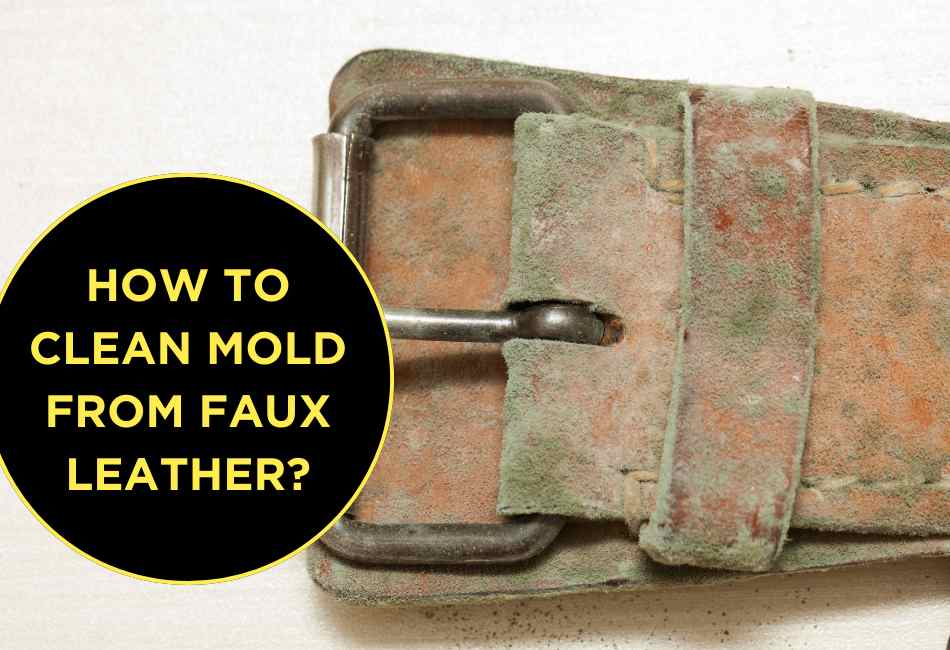Faux leather has gained substantial popularity over the years due to its affordability, durability, and environmentally friendly nature. It has become a staple material in many homes, adorning everything from furniture to fashion accessories.
Despite its numerous advantages, faux leather requires regular maintenance to retain its aesthetic appeal, particularly to prevent mold growth, which can cause significant damage.
Mold on faux leather isn’t just unsightly; it can gradually degrade the material, losing its luster and durability.
This blog post will guide you through some simple yet effective home remedies to clean mold off your faux leather items, helping you maintain their charm and longevity.
How Does Faux Leather Get Mold?
1. Exposure to moisture and humidity
Let me share a little anecdote with you. I once left my beloved faux leather jacket out on the patio overnight.
Surprisingly, it rained that night, and the jacket was soaking wet the next morning. I quickly dried it off but didn’t realize the damage was already done.
Excessive moisture had crept into the material, creating a perfect breeding ground for mold.
2. Improper storage conditions
I once stored a faux leather purse in an old, damp basement for the winter. Come spring, I was greeted with a moldy mess.
Always remember that faux leather items must be stored in a dry, ventilated area to prevent mold growth.
3. Lack of regular cleaning and maintenance
Back then, I was not as meticulous about cleaning as I am now. I had this faux leather recliner that I used to neglect for regular cleaning. And as you might have guessed, this made way for the uninvited guest – mold.
Subtle signs of mold development on faux leather
- Discoloration
One time, I noticed unusual spots on my faux leather boots. They had changed color, appearing lighter than the rest of the material. It was only then I realized it was mold starting to take hold.
- Musty odor
I wish I had known earlier that a musty smell often indicates mold growth. I learned this the hard way when my faux leather couch started to give off a peculiar odor, and I soon discovered it was due to mold.
- White fuzz
Don’t just brush it off as lint if you see white fuzz on your faux leather items. This is a tell-tale sign of mold.
- Surface changes
Mold can cause the surface of faux leather to become rough, discolored, or cracked. If you notice any of these changes in texture, it’s time to address the issue before it spreads further.
The Effects of Mold on Faux Leather
Deterioration of material quality
- Weakening of the fabric structure
Believe it or not, mold can gradually weaken the structure of faux leather. I had a faux leather ottoman that started sagging, and I couldn’t figure out why.
Upon closer inspection, I found mold and eventually learned it was the culprit behind the weakening structure.
- Loss of color vibrancy
I was heartbroken when my bright red faux leather jacket lost its vibrancy due to mold growth. The color had faded significantly, and it was no longer the same eye-catching piece.
Health concerns
- Allergies and respiratory issues
My sister once developed a persistent cough when she moved into a room with mold-filled faux leather furniture. It wasn’t until later we realized it was the mold causing the respiratory issues.
This has led me to believe in the importance of immediate mold removal, not only for faux leather items but, more importantly, for our health.
Home Remedies for Cleaning Faux Leather Mold
1. White Vinegar Solution
- Mixing ratio and application
I have found that white vinegar makes an effective solution for cleaning mold off faux leather. The acidic property of vinegar helps kill the mold and prevent it from returning.
The mixing ratio I typically use is one part vinegar to two parts water. I pour the solution into a spray bottle and lightly mist the affected areas.
- Gently scrubbing the affected areas
Once I’ve sprayed the vinegar solution, I use a soft-bristled brush to scrub the moldy spots gently.
It’s important to be gentle during this process to avoid damaging the faux leather. After scrubbing, I wipe away the solution with a clean, damp cloth and let it dry naturally.
2. Baking Soda Paste
- Creating a paste with water
Another DIY method I have used with success is a baking soda paste. Baking soda is a natural mold killer and helps remove any lingering moldy smell.
I mix equal parts of baking soda and water to create the paste. About a tablespoon of each usually gives me enough paste to cover a small moldy area.
- Applying and letting it sit
I apply the paste directly onto the mold spots using a cloth or an old toothbrush. I then let it sit for about 10-15 minutes.
This gives the baking soda time to work its magic. Following this, I gently scrub the area with the cloth or toothbrush (whichever I didn’t use to apply the paste) and then wipe it clean.
After cleaning, I always let the faux leather dry completely to prevent any new mold from forming.
With these homemade solutions, not only have I been able to maintain the integrity of my beloved faux leather items, but I’ve also been able to protect my home and loved ones from potential health issues related to mold exposure.
3. Lemon Juice and Salt
- Mixing ingredients for a natural cleaning solution
One sunny Saturday afternoon, I tried a new homemade mold-cleaning solution involving two common kitchen items – lemon juice and salt.
I squeezed the juice from one fresh lemon into a bowl, removing any seeds. Then, I added about a teaspoon of salt, stirring until it dissolved.
I was surprised at how quickly these simple ingredients combined to form a rather effective mold remover.
- Rubbing the mixture on mold spots
I took an old toothbrush and dipped the bristles into the lemon-salt solution. Then, carefully, I began to rub the mixture onto the moldy spots on my faux leather couch.
The citrusy smell of the lemon made the process quite enjoyable. After scrubbing gently for a few minutes, I wiped the area clean with a damp cloth and let it dry.
The mold was gone, to my delight, and my faux leather couch looked as good as new!
4. Rubbing Alcohol
- Diluting alcohol with water
One day, while looking for a quick solution to tackle a small mold spot on my faux leather jacket, I stumbled upon a method using rubbing alcohol.
I filled a spray bottle with one part rubbing alcohol and one part water. I was initially hesitant, fearing the alcohol could potentially damage the faux leather, but I did a patch test first, which put my worries to rest.
- Wiping down faux leather surfaces
After shaking the bottle to mix the solution, I sprayed it directly onto the mold spot. Then, with a clean cloth, I thoroughly wiped the area.
This method was faster and required less elbow grease. After I was done, I let the jacket air dry.
Within an hour, the mold spot had completely disappeared, and the jacket seemed to have regained some of its lost sheen.
Since then, rubbing alcohol has become my go-to solution for quick and efficient mold removal on faux leather.
5. Tea Tree Oil
- Mixing oil with water in a spray bottle
Like many, I have long admired tea tree oil’s antiseptic properties and often use it for minor cuts and burns. So, when I discovered its potential as a mold remover, I was eager to try it.
I filled my trusty spray bottle with one teaspoon of tea tree oil for every cup of water. The oil didn’t fully dissolve in the water, but that didn’t deter me. I gave it a good shake before each use to ensure a proper mix.
- Spraying on affected areas
I lightly sprayed the tea tree solution onto a moldy spot on my beloved faux leather bag. I let it sit for about an hour before wiping it off with a clean, damp cloth.
The mold was gone, leaving the bag with a faint, refreshing scent. I was thrilled with the results! Thanks to tea tree oil, I saved my bag from being discarded.
6. Commercial Mold Removers (optional)
- Store-bought alternatives
There have been occasions when the mold on my faux leather items was too stubborn for my homemade remedies.
I relied on commercial mold removers as a last resort during these times. There are numerous options on the market, and many work quite effectively.
- Caution regarding chemical ingredients
While these store-bought solutions can be lifesavers, it’s important to remember they often contain harsh chemicals.
Always do a patch test first to avoid ruining your faux leather items. I once had a mishap with a particular brand that left a faded spot on my faux leather sofa.
Since then, I’ve learned to take extra care using commercial mold removers.
Preventive Measures
Preventing mold from appearing in the first place can save you a lot of time, not to mention the health of your faux leather items. Here are some methods that have worked for me over the years:
Proper Storage Tips
- Adequate Ventilation
In my various encounters with mold, I’ve realized that poor ventilation is often a major culprit. I used to store my faux leather items in a cramped, stuffy closet – a perfect breeding ground for mold.
Since then, I’ve reorganized my storage, ensuring ample air circulation around each item. This simple change has significantly reduced my mold problems.
- Avoiding Direct Sunlight Exposure
While letting your items breathe is important, direct sunlight can be damaging. I learned this the hard way when my favorite faux leather purse faded dramatically after being left in the sun.
I ensure my items are stored in a well-ventilated but not overly sunny spot.
Regular Cleaning Routine
- Gentle Wiping with a Damp Cloth
Over time, I’ve found that a simple wipe-down can work wonders for preventing mold.
I habitually gently wipe my faux leather items with a barely damp cloth every few weeks.
This helps keep mold at bay and keeps my things looking fresh and clean.
- Periodic Deep Cleaning
While regular wipe-downs are helpful, nothing beats a thorough deep clean now and then
At least once a year, I set aside an afternoon to clean all my faux leather items with a mild soap solution.
This process might take some time, but seeing my belongings mold-free and gleaming makes it all worth it.


